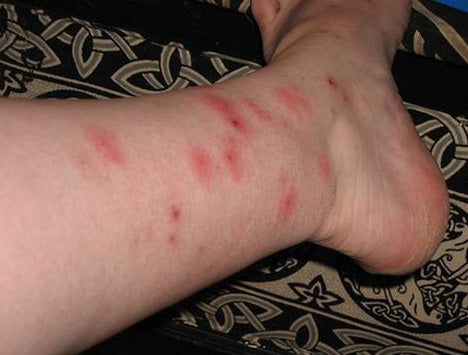There’s nothing quite like getting into bed at the end of the day. You snuggle down under the blanket, drop your head into the pillow, and fully relax for the first time all day. While more than a handful of things can disrupt our sleep, one of the worst is a suspicion of bed bugs.
Just the thought of them crawling around and over our skin can send us rocketing out of bed. Bed bugs tend to be nocturnal creatures since they like the cover of darkness in which to feed, but all they really want is a cozy place in close quarters to your skin so they can drink your blood.
The problem is, bed bug bites often cause little-to-no reaction, so those little red patches on your skin may be a heat rash or hives. So how do you tell the difference? Read on to find out.
Heat Rash vs. Bed Bugs: How to Tell the Difference
What do bed bug bites look like?

- They’re on exposed areas of skin- While heat rash is likely to occur where you’re hottest overnight, bed bug bites will appear on exposed areas of skin. If you tend to sleep without pajamas on, this may not be as easy to identify but think about the position you lie in most. Are the marks on the side you sleep on, or the side that is covered by your blanket? Bed bug bites are more likely to appear on the latter.
- They are often in a line or cluster- Bed bug bites tend to look like a little bug came along and snacked on you in a small area. There are usually more than 5 or 6 bites in one location - less than that, and the bite is more likely due to a mosquito (if exposed to the air), a tiny spider, or even a flea if you have pets.
- You won’t notice when bed bugs bite- While this doesn’t affect how the bite looks; it’s worth knowing that bed bug bites are painless at the time of the bite. Their saliva numbs the skin, essentially giving you a local anesthetic while they feed. It’s only later that you may develop itchiness. If you’re feeling a bite (and are sure it’s not imagined), you’re more likely to be dealing with fleas.
- They may itch- Some people have absolutely no symptoms from bed bug bites, but many of us experience redness and itchiness at the site of the bite. If you have an allergic reaction to the bite, it may come with skin irritation, such as a blister or lump.
- Bites increase over time- Bed bug bites will increase at night as the bed bug's breed. Heat rash should reduce by taking measures to stay cool during the night.
- Bites are usually individual red patches - If you are someone who reacts to bed bug bites, the red patches are usually individual circles (with some overlap) 5-10mm across.
- Other people in your household may have them - If you notice a bite on you, ask the other people living in your home if they’ve had any bites. While heat rash is not contagious, bed bugs do their best to spread.
What does heat rash look like?
- It looks more like a rash than an individual circle- Heat rash tends to look more like a large patch of redness, with lots of tiny circles within the rash, which are usually only 2-4mm across and may not be visible in the middle of the rash.
- It appears where there has been excess sweating- heat rash appears where the skin has tried to cool down but has been unable to do so properly. You’re most likely to find it where you have skin-to-skin contact (such as inner thighs) or where your skin touches your bed sheet if it is not made from a breathable fabric.
What about hives?
Hives and heat rash are similar, the only difference being that hives usually come up in big angry patches (called “plaques” when joined together), rather than lots of tiny red circles close together. They are not usually smaller than a pencil eraser and can get up to the size of a dinner plate.
Hives usually appear suddenly due to an allergic reaction or stress reaction. While hives can result from skin contact with something you are allergic to, they can appear “spontaneously” due to emotional stress or ingesting something you are allergic to.
Heat Treatments Are the Answer for Bites
If you have confirmed you’re getting bitten bed bugs, performing a heat treatment at home is the safest way to guarantee your home is pest-free. Investing in a bed bug heater package is the best option for those who need a fast, effective, and safe bed bug heat treatment. To find out more about our heat treatment packages, click here.

